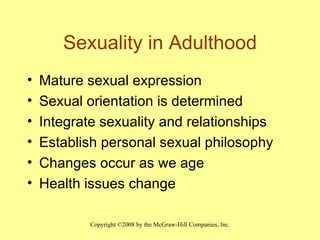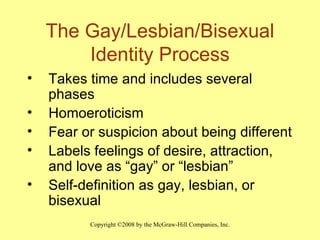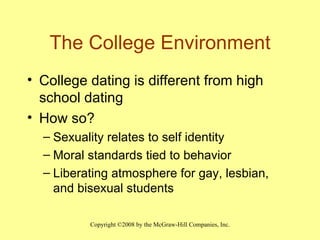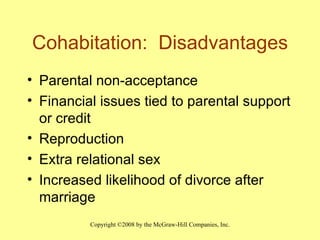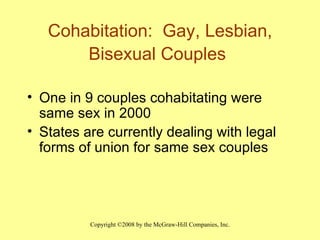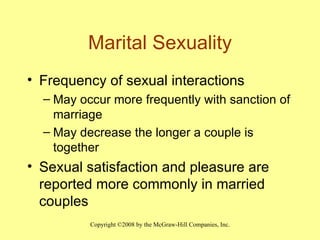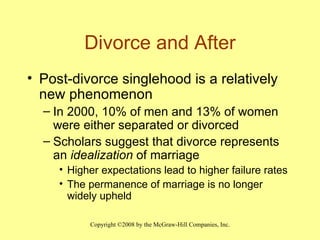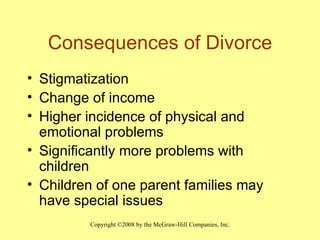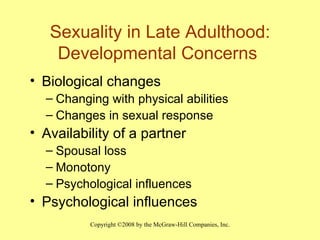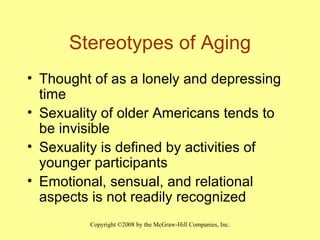strong6_ppt_ch07
- 1. Chapter Seven Sexuality in Adulthood
- 2. Sexuality in Adulthood Mature sexual expression Sexual orientation is determined Integrate sexuality and relationships Establish personal sexual philosophy Changes occur as we age Health issues change
- 3. Developmental Concerns Establishing sexual orientation Integrating love and sex Forging intimacy and making commitments Making fertility/childbearing decisions Practicing safer sex Evolving a sexual philosophy
- 4. Establishing Sexual Orientation Understanding your sexual orientation Accepting your sexual orientation It may be difficult
- 5. Statistics on Sexual Orientation Difficult to obtain reliable statistics vs. estimates due to stigma 10% women report lesbian orientation 4% men report gay or bisexual orientation A great deal of experiential diversity is reported
- 6. The Gay/Lesbian/Bisexual Identity Process Takes time and includes several phases Homoeroticism Fear or suspicion about being different Labels feelings of desire, attraction, and love as “gay” or “lesbian” Self-definition as gay, lesbian, or bisexual
- 7. The Gay/Lesbian/Bisexual Identity Process — Additional Phases First same-sex love affair, marking commitment to unifying sexuality and affection Becoming involved in gay/lesbian/bisexual culture Coming out Internalized homophobia
- 8. Being Single Greater sexual experience Widespread acceptance of cohabitation Unintended pregnancies Increased numbers of abortions and births to single women Greater numbers of separated and divorced single men and women A rise in the number of single-parent families
- 9. The College Environment College dating is different from high school dating How so? Sexuality relates to self identity Moral standards tied to behavior Liberating atmosphere for gay, lesbian, and bisexual students
- 10. The Singles World Ages 25-40 Emphasize recreation and entertainment Challenge to meet potential partners Sexual experimentation Gay, lesbian, bisexual businesses and neighborhoods promote acceptance Ethnic and religion expectations can pose special challenges
- 11. Cohabitation 2000 census: over 10 million unmarried couples were reported 1 in 4 women and 3 in 10 men New norm Domestic partnership Serial monogamy
- 12. Cohabitation: Advantages Financial Egalitarian roles Affirmation of relationship Domestic partner benefits
- 13. Cohabitation: Disadvantages Parental non-acceptance Financial issues tied to parental support or credit Reproduction Extra relational sex Increased likelihood of divorce after marriage
- 14. Cohabitation: Gay, Lesbian, Bisexual Couples One in 9 couples cohabitating were same sex in 2000 States are currently dealing with legal forms of union for same sex couples
- 15. Cohabitation: Gay, Lesbian, Bisexual Issues Stigma of casual relationships Marriage is not available Non-exclusive sexuality Devaluing love Non-traditional gender roles Societal hostility
- 16. Sexuality in Middle Adulthood: Developmental Concerns Redefining sex in marital or other long-term relationships Reevaluating one’s sexuality Accepting the biological aging process
- 17. Marital Sexuality Frequency of sexual interactions May occur more frequently with sanction of marriage May decrease the longer a couple is together Sexual satisfaction and pleasure are reported more commonly in married couples
- 18. Marital Sexuality The moral and social sanction of sex within marriage can affect sex life Sexual intercourse tends to decrease in frequency the longer a couple is married Decreased frequency does not indicate decreased importance or enjoyment Fatigue and lack of private time are important factors Sexual satisfaction and pleasure are higher in marriage than in singlehood
- 19. Divorce and After Post-divorce singlehood is a relatively new phenomenon In 2000, 10% of men and 13% of women were either separated or divorced Scholars suggest that divorce represents an idealization of marriage Higher expectations lead to higher failure rates The permanence of marriage is no longer widely upheld
- 20. Consequences of Divorce Stigmatization Change of income Higher incidence of physical and emotional problems Significantly more problems with children Children of one parent families may have special issues
- 21. Dating Again Engaging in sexual behavior with someone following separation is significant Helps people accept their single status Freedom of expression Dating is more focused and less leisurely
- 22. Single Parenting 31% of families are headed by single parents Single parents not often part of the “singles world” Presence of children affects divorced women’s sexual activity
- 23. Sexuality in Late Adulthood: Developmental Concerns Biological changes Changing with physical abilities Changes in sexual response Availability of a partner Spousal loss Monotony Psychological influences Psychological influences
- 24. Stereotypes of Aging Thought of as a lonely and depressing time Sexuality of older Americans tends to be invisible Sexuality is defined by activities of younger participants Emotional, sensual, and relational aspects is not readily recognized
- 25. Sexuality and Aging The emotional, sensual, and relationship aspects of sexuality are enjoyed regardless of age Sexual activities occur in aging population Health can affect sexual habits Medical definition of sexual practices
- 26. AARP 2005 Survey 1/3 of respondents report having sexual intercourse weekly Majority agreed emphasis on sex is excessive 2/3 discuss sexual satisfaction Health influences sexual satisfaction Many have identified issues to increase satisfaction
- 27. Women’s Issues Change in fertility Menstruation loss Menopausal symptoms Hot flashes Loss of bone mass Changes in vagina
- 28. Differences Women Report Pre- and Post-Menopause Majority report sexual activity and rate sexual activity as important Over one third report decreased desire but not decreased satisfaction 20% report sex may be painful Ethnic differences for sexual activity were not found
- 29. Men’s Issues Male climacteric: Age 40 to 60 Less than 20% report difficulty with erection Slower sexual responses may be reported Slower responses are not related to ability to give or receive pleasure
- 30. Summary Early adulthood Middle adulthood Late adulthood
Editor's Notes
- 5
- 6
- 7

